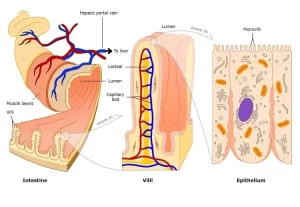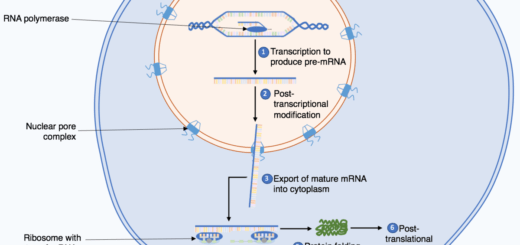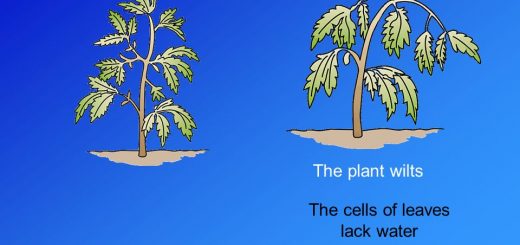Small intestine, Absorption of digested food, Metabolism, Large intestine and defecation
The small intestine consists of the duodenum and ileum, It is about 8 meters long, It is about 3.5 cm in diameter at its beginning reaches 1.25 cm at its end, The coils and loops of the small intestine are connected by a membranous structure called the mesentery, The juices that help to digest food in the small intestine are bile juice, pancreatic juice and intestinal juice.
Bile juice
The liver secretes bile which passes through the bile duct to be stored in the gallbladder until needed, Bile juice is secreted from the liver on the food during its passage in the duodenum and it does not contain digestive enzymes, It emulsifies fats, dividing the large masses of fats into small globules to facilitate and accelerate the enzymatic action on fats that do not dissolve in water.
Fats → Emulsified (Bile juice)
Pancreatic juice
It is secreted from the pancreas on the food in the duodenum, Pancreatic juice includes Sodium bicarbonate, Pancreatic amylase, Trypsinogen enzyme, and Lipase enzyme.
Sodium bicarbonate neutralizes HCl and renders (makes) the medium alkaline (pH = 8), Pancreatic amylase catalyzes the hydrolysis of glycogen and starch into maltose.
Starch and glycogen + Water → Maltose (Malt sugar)
Trypsinogen enzyme is an inactive enzyme, It becomes active trypsin in the duodenum by the enterokinase enzyme that is secreted by the intestinal glands in the lining of the small intestine, Trypsin catalyzes the hydrolysis of protein into polypeptides.
Trypsinogen ( Inactive) → Trypsin ( active ), (Enterokinase)
Protein + Water → Polypeptides , (Trypsin, Alkaline medium)
Lipase enzyme catalyzes the hydrolysis of emulsified fats into fatty acids and glycerol.
Emulsified fats + Water → Fatty acids + Glycerol , (Lipase, alkaline medium)
Intestinal juice
It is secreted by certain cells in the wall of the small intestine which contains a mixture of enzymes, These enzymes complete the action of the previous enzymes and end the action of digestion of all food constituents, These enzymes are Peptidases, Maltase, Sucrase, Lactase and Enterokinase enzyme.
Peptidases are a number of enzymes, each one is concerned with the hydrolysis of peptide linkages between certain kinds of amino acids in the polypeptide chains to give various amino acids.
Polypeptide chain → Amino acids , (Peptidases, Alkaline medium)
Enzymes which hydrolyze the disaccharides into monosaccharides , these are:
Maltase hydrolyzes maltose ( malt sugar ) into two molecules of glucose.
Maltose → Two molecules of glucose (Maltase, Alkaline medium)
Sucrase hydrolyzes sucrose (cane sugar) into glucose and fructose (fruit sugar).
Sucrase → Glucose + Fructose (Sucrase, Alkaline medium)
Lactase hydrolyzes lactose (milk sugar) into glucose and galactose.
Lactose → Glucose + Galactose (Lactase, Alkaline medium).
Enterokinase enzyme is not from the digestive enzymes, but it acts only as a co-enzyme to activate the trypsinogen enzyme.
Digestive enzymes are used in some detergents, as they can remove patches resulted from organic materials such as sweat, blood, and vegetarian substances.
Absorption of digested food
Absorption is the transfer of digested food to the blood or lymph through the mucosa of the ileum, The inner epithelial lining of the ileum is folded to form villi, The surface area increases and reaches about 10 m², about 5 times as much as the surface area of the human body.
Villi are many folds in the inner wall of the ileum which cause an increase in the surface area of the small intestine that is subjected to the absorption of digested food.
Structure of the villus
Epithelial layer: A single layer of epithelial cells encloses a lacteal vessel that is surrounded by a network of venous and arterial blood capillaries.
Micro-villi: Tiny projections from the epithelial cells of the villus, observed by the electron microscope, They increase the surface area of absorption.
Routes of absorption of the digested food substances by the villi
The products of digestion are transferred to the blood and lymph by absorption through the villi by the active transport and membranal diffusion , there are two routes in which the absorbed food substances pass in the villi, which are:
Blood route
It starts with the blood capillaries inside the villi, The blood inside blood capillaries carries water, mineral salts, glucose, amino acids, and some water-soluble vitamins, These substances are carried to the hepatic portal vein to the liver, then through the hepatic vein to be emptied into the inferior vena cava, then to the heart.
Lymphatic route
Fatty acids and glycerol pass through it with some water-insoluble vitamins (A, D, E and K), Some of these fatty acids and glycerol may recombine in the epithelial cells of villi to form fats again.
Some of the finely emulsified fats are absorbed directly by being engulfed by the epithelial cells, All fats pass into the lacteals inside the villi to the lymphatic system which carries them slowly and empties them into the superior vena cava, then to the heart.
Metabolism
Metabolism is the process by which the body can utilize the absorbed food, This process takes place in two ways which are anabolism and catabolism.
Anabolism is the process by which simple and small-sized food particles are changed into complex compounds.
Examples: Glucose can be changed into glycogen and stored in the liver and muscles, Amino acids can be changed into different forms of polypeptides to build up the new tissues, and Fatty acids and glycerol can be changed into fats and stored mainly under the skin.
Catabolism is the process by which the absorbed food (especially the glucose) is oxidized to produce the energy required for the vital activities of the body.
The feeding of hunger refers to the glucose level in the blood, where the glucose level drops during fasting or after a long period of eating to the sub-standard level (less than the normal level), then when this blood reaches the brain, it excites the brain to send signals to the empty stomach, so, severe stomach contractions occur that represent the pangs of hunger.
Large intestine and defecation
The undigested food passes to the large intestine, Water and salts from the undigested food are absorbed through the lining of the epithelial wall of the large intestine, as it has many convolutions to help in the absorption, Wastes become semi-solid faeces and have a bad odour, due to the presence of certain types of bacteria.
Wast remains are expelled as faeces through the anus by means of strong muscular contractions of the rectum accompanied by the relaxation of two muscles of the anal sphincters situated on both sides of the anus, The mucosa of large intestine secretes mucus to facilitate the passage of faeces to outside.
Digestion in man, Buccal digestion and Gastric digestion (digestion in stomach)
Chemical reactions in organism’s bodies (Metabolism and Enzymes)




